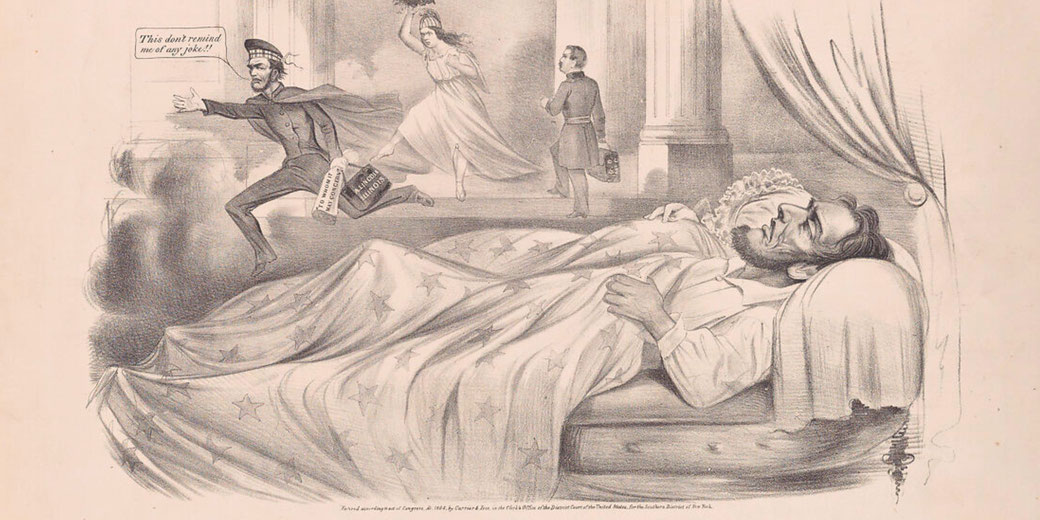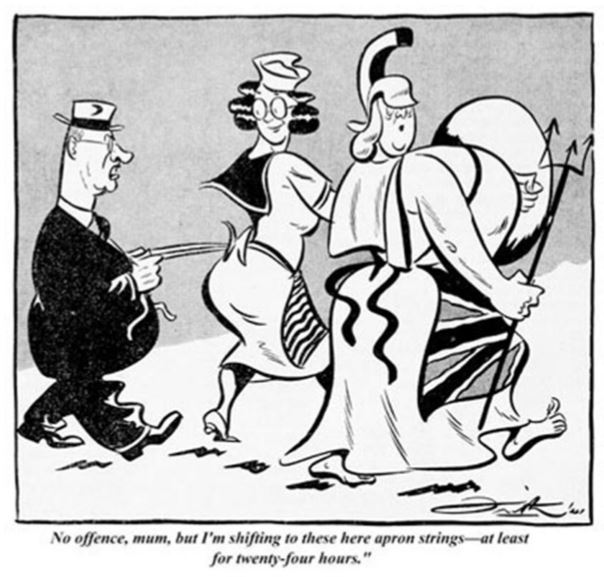How to interpret the meaning of political cartoons

Interpreting a visual source, like a political cartoon, is very different to interpreting words on a page, which is the case with written sources.
Therefore, you need to develop a different set of skills.
What is a 'political cartoon'?
Political cartoons are ink drawings created to provide a humorous or critical opinion about political events at the time of its creation.
They were particularly popular in newspapers and magazines during the late 19th and early 20th centuries. However, they are still used by many newspapers, magazines and websites today.
While political cartoons can be funny, that is usually not their main purpose. They were primarily created to persuade their audience to take a particular view on a historical event.
A successful political cartoon can change someone’s mind so that they ultimately agree with the cartoonist’s point of view.
Further information:
Learn more about the history of the political cartoon with this short YouTube clip:

If you've never seen a political cartoon before, you can see a contemporary one being made below:

How do I understand the meaning of a political cartoon?
Understanding what a historical political cartoon means can be difficult for us because we did not live through the political events the cartoons talk about.
However, all political cartoons rely heavily upon a very simple visual ‘code’ rather than relying solely on words to convey their message.
Once we learn how this visual code works, we can use it to ‘decode’ the specific message of a cartoon.
Political Cartoon Visual Codes
Cartoonists intentionally draw people or characters with physical features that are larger than they naturally are. They do this in order to make a point.
Usually, the point is to highlight something about the character of a person. For example, if a person is drawn with a large, toothy grin, it can be a sign that they have evil intentions and are untrustworthy.
Therefore, when interpreting a cartoon, look for any physical features that seem obviously exaggerated. Then, try to decide what point the creator was trying to make about the person.
If you want to see how a cartoonist uses caricatures, watch the short clip below:

To help their audience understand what each person represents in their drawings, cartoonists often write a name on the major figures. Common names include famous politicians or countries.
So, when you’re interpreting a cartoon, look for the labels. You might need to do some background research to find out who the people are before you continue with your interpretation.
3. Symbolism
Cartoonists use simple objects, or symbols, that the general public would be familiar with. These symbols are used to represent important concepts or ideas.
For example, using a ‘skull and crossbones’ could represent ‘death’ or ‘danger’. While you’re interpreting a cartoon, identify any symbols and try to work out what concept the image is meant to represent.
Here are some common symbols used in political cartoons, along with their common meanings:
| Symbol | Meaning(s) | Symbol | Meaning(s) | Symbol | Meaning(s) |
| Anchor | safety, security | Bear | Russia | Bulldog | Great Britain |
| Chains | imprisonment, slavery | Crowd of People | unstoppable force | Cupid | love |
| Dollar Sign | money | Door/gate | access, entry | Dove | peace |
| Eagle | America | Grave Stone | death | Grim Reaper | Death |
| Hammer & Sickle | communism | Hare | carelessness, arrogance | Hourglass | limited time |
| Imperial Dragon | China | Kangaroo | Australia | Lamb | innocence |
| Octopus | greed | Ostrich | refusal to hear bad news | Owl | wisdom |
| Puppet | being controlled | Rainbow | hope, future | Rat | infection, disease |
| Red Star | communism | Rose | love | Samurai | Japan |
| Sheep | blind trust | Skull | death | Snake | evil, temptation |
| Spider/web | control, entrapment | Spiked Helmet | German | Star of David | Jews or Israel |
| Stars and Stripes | America | Swastika | Nazis, Nazism | Throne | power |
| Turtle | slow, vulnerable | Uncle Sam | America | Wall | division, separation |
| Woman with flag | a specific country | Woman with scales | justice | Young Child | naivety, innocence, victim |
4. Captions
Another handy way that cartoonists convey important information to their audience is by providing a written explanation through a speech bubble in the cartoon itself or a caption at the bottom of the image.
These words should help you understand the main historical event or issue that the image is based upon.
5. Analogies
An analogy is a comparison between two different things to highlight a particular similarity in ideas. Through the comparison of a complex political issue with more simplistic, 'everyday' scenarios with which the audience would be more familiar, a cartoonist can more easily convey their message.
Here are some common analogies and what they could mean in political cartoons:
| Analogy | Meaning(s) | Analogy | Meaning(s) | Analogy | Meaning |
| Boss & Employee | Shows a power difference | Crucifixion |
Shows an innocent sacrifice |
Marriage | Shows a close relationship |
| Parent & Child | Shows dependence or care | Predator & Prey | Shows impending destruction | Shipwreck | Shows a disaster |
6. Stereotypes
It was very common for cartoonists to represent a particular group of people (usually in a very racist way) using stereotypes.
A stereotype is an over-simplification of what a particular racial group looks like. For example, Chinese people in the 19th century were drawn with a long pony-tail in their hair.
Cartoonists use this so that audiences can readily identify which people group is the target of the cartoon. Getting to know common stereotypes can be quite confronting for us, since they can be very derogatory in nature.
However, once you become familiar with common forms of stereotyping, you can identify the appropriate people group being targeted in a particular cartoon.
Common Stereotypes:
Example:





People Group:
Germans
Chinese
Japanese
Australians
Jewish People
Exaggerated Features:
Pickelhaube (the spiked helmet), gorilla-like body
Long ponytail, narrow eyes, thin moustache, traditional Chinese clothes and hat, two large front teeth
Circular glasses, narrow eyes, toothy grin
Slouch hat, clean-shaven, khaki clothes
Large nose, kippah (Jewish prayer cap)
How do I write an interpretation?
Once you have deconstructed the cartoon, now you can start creating your explanation. To do so, answer the following questions:
- Who or what is represented by the characterisation, stereotypes and symbols?
- Who or what have been labelled?
- What information is provided by the caption?
- What is the political issue being mentioned in the cartoon? (You may need to do some background research to discover this).
- What is the analogy that this cartoon is based upon?
Once you have answered these questions, you are ready to answer the final one:
- What did the cartoonist want the audience to think about the issue?
What do I do with my interpretation?
Identifying the message of a political cartoon shows that you understand the primary source, which means that you can use it as an indirect quote in your historical writing.
Your interpretation can also help you in your analysis and evaluation of the source. For example, identifying the source's message can help you ascertain:
Example

Frith, J. (31st December, 1941). 'No offence, mum...', The Bulletin.
Demonstrating interpretation of political cartoons in your writing:
The political cartoon by Frith makes a comment on Australia's changing diplomatic relationships between Great Britain and America during the Second World War. The cartoonist does this through the depiction of three main characters. The man on the left is clearly a caricature of Australian prime minister John Curtin, as he was commonly drawn with his distinctive hat and glasses. The woman on the right of the image is meant to symbolise Great Britain. This symbolism is clear due to the use of the Union Jack, the flag of Great Britain, drawn upon her apron. Furthermore, she is depicted as the mythical figure of Britannia, a common representation of Britain. The second woman is meant to be America, as she is drawn with a stereotypical 1940s American hairstyle and clothing. This symbolism is reinforced by the depiction of the stripes of the American flag drawn on her apron. The primary analogy the cartoon uses is the idea of 'holding onto your mother's apron strings', which is used to describe a young child depending on their mother for comfort and security. This analogy is evident in the image caption which explicitly states that Curtin is "shifting to these here apron strings". The overall message of the cartoon is that Curtin is switching Australia's dependence from Great Britain to America for comfort and security. It is meant to be a satirical comment on the childish dependency that Australia demonstrated during the early years of the Second World War.
What do you need help with?
Download ready-to-use digital learning resources
Copyright © History Skills 2014-2025.
Contact via email
With the exception of links to external sites, some historical sources and extracts from specific publications, all content on this website is copyrighted by History Skills. This content may not be copied, republished or redistributed without written permission from the website creator. Please use the Contact page to obtain relevant permission.





